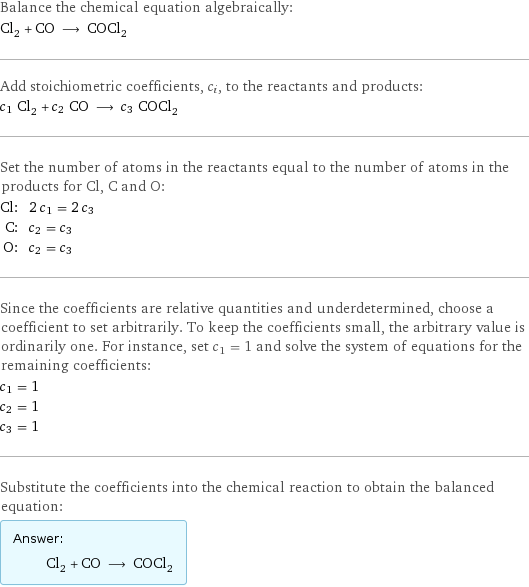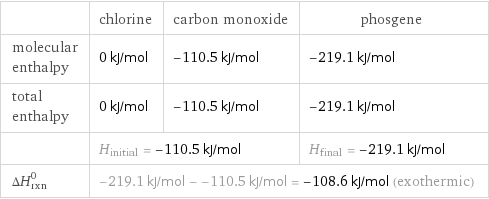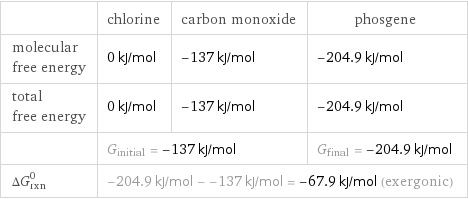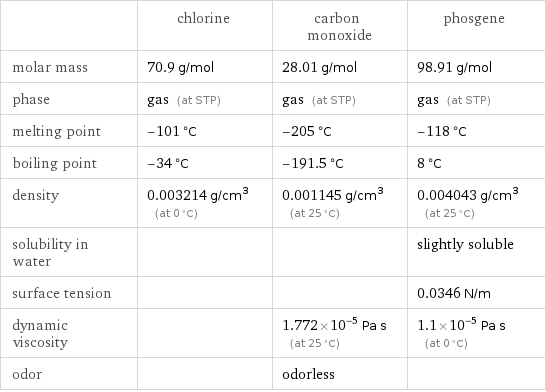Input interpretation

Cl_2 chlorine + CO carbon monoxide ⟶ COCl_2 phosgene
Balanced equation

Balance the chemical equation algebraically: Cl_2 + CO ⟶ COCl_2 Add stoichiometric coefficients, c_i, to the reactants and products: c_1 Cl_2 + c_2 CO ⟶ c_3 COCl_2 Set the number of atoms in the reactants equal to the number of atoms in the products for Cl, C and O: Cl: | 2 c_1 = 2 c_3 C: | c_2 = c_3 O: | c_2 = c_3 Since the coefficients are relative quantities and underdetermined, choose a coefficient to set arbitrarily. To keep the coefficients small, the arbitrary value is ordinarily one. For instance, set c_1 = 1 and solve the system of equations for the remaining coefficients: c_1 = 1 c_2 = 1 c_3 = 1 Substitute the coefficients into the chemical reaction to obtain the balanced equation: Answer: | | Cl_2 + CO ⟶ COCl_2
Structures

+ ⟶
Names

chlorine + carbon monoxide ⟶ phosgene
Reaction thermodynamics
Enthalpy

| chlorine | carbon monoxide | phosgene molecular enthalpy | 0 kJ/mol | -110.5 kJ/mol | -219.1 kJ/mol total enthalpy | 0 kJ/mol | -110.5 kJ/mol | -219.1 kJ/mol | H_initial = -110.5 kJ/mol | | H_final = -219.1 kJ/mol ΔH_rxn^0 | -219.1 kJ/mol - -110.5 kJ/mol = -108.6 kJ/mol (exothermic) | |
Gibbs free energy

| chlorine | carbon monoxide | phosgene molecular free energy | 0 kJ/mol | -137 kJ/mol | -204.9 kJ/mol total free energy | 0 kJ/mol | -137 kJ/mol | -204.9 kJ/mol | G_initial = -137 kJ/mol | | G_final = -204.9 kJ/mol ΔG_rxn^0 | -204.9 kJ/mol - -137 kJ/mol = -67.9 kJ/mol (exergonic) | |
Equilibrium constant
![Construct the equilibrium constant, K, expression for: Cl_2 + CO ⟶ COCl_2 Plan: • Balance the chemical equation. • Determine the stoichiometric numbers. • Assemble the activity expression for each chemical species. • Use the activity expressions to build the equilibrium constant expression. Write the balanced chemical equation: Cl_2 + CO ⟶ COCl_2 Assign stoichiometric numbers, ν_i, using the stoichiometric coefficients, c_i, from the balanced chemical equation in the following manner: ν_i = -c_i for reactants and ν_i = c_i for products: chemical species | c_i | ν_i Cl_2 | 1 | -1 CO | 1 | -1 COCl_2 | 1 | 1 Assemble the activity expressions accounting for the state of matter and ν_i: chemical species | c_i | ν_i | activity expression Cl_2 | 1 | -1 | ([Cl2])^(-1) CO | 1 | -1 | ([CO])^(-1) COCl_2 | 1 | 1 | [COCl2] The equilibrium constant symbol in the concentration basis is: K_c Mulitply the activity expressions to arrive at the K_c expression: Answer: | | K_c = ([Cl2])^(-1) ([CO])^(-1) [COCl2] = ([COCl2])/([Cl2] [CO])](../image_source/f70ba6d64807d993a04fd0533a962765.png)
Construct the equilibrium constant, K, expression for: Cl_2 + CO ⟶ COCl_2 Plan: • Balance the chemical equation. • Determine the stoichiometric numbers. • Assemble the activity expression for each chemical species. • Use the activity expressions to build the equilibrium constant expression. Write the balanced chemical equation: Cl_2 + CO ⟶ COCl_2 Assign stoichiometric numbers, ν_i, using the stoichiometric coefficients, c_i, from the balanced chemical equation in the following manner: ν_i = -c_i for reactants and ν_i = c_i for products: chemical species | c_i | ν_i Cl_2 | 1 | -1 CO | 1 | -1 COCl_2 | 1 | 1 Assemble the activity expressions accounting for the state of matter and ν_i: chemical species | c_i | ν_i | activity expression Cl_2 | 1 | -1 | ([Cl2])^(-1) CO | 1 | -1 | ([CO])^(-1) COCl_2 | 1 | 1 | [COCl2] The equilibrium constant symbol in the concentration basis is: K_c Mulitply the activity expressions to arrive at the K_c expression: Answer: | | K_c = ([Cl2])^(-1) ([CO])^(-1) [COCl2] = ([COCl2])/([Cl2] [CO])
Rate of reaction
![Construct the rate of reaction expression for: Cl_2 + CO ⟶ COCl_2 Plan: • Balance the chemical equation. • Determine the stoichiometric numbers. • Assemble the rate term for each chemical species. • Write the rate of reaction expression. Write the balanced chemical equation: Cl_2 + CO ⟶ COCl_2 Assign stoichiometric numbers, ν_i, using the stoichiometric coefficients, c_i, from the balanced chemical equation in the following manner: ν_i = -c_i for reactants and ν_i = c_i for products: chemical species | c_i | ν_i Cl_2 | 1 | -1 CO | 1 | -1 COCl_2 | 1 | 1 The rate term for each chemical species, B_i, is 1/ν_i(Δ[B_i])/(Δt) where [B_i] is the amount concentration and t is time: chemical species | c_i | ν_i | rate term Cl_2 | 1 | -1 | -(Δ[Cl2])/(Δt) CO | 1 | -1 | -(Δ[CO])/(Δt) COCl_2 | 1 | 1 | (Δ[COCl2])/(Δt) (for infinitesimal rate of change, replace Δ with d) Set the rate terms equal to each other to arrive at the rate expression: Answer: | | rate = -(Δ[Cl2])/(Δt) = -(Δ[CO])/(Δt) = (Δ[COCl2])/(Δt) (assuming constant volume and no accumulation of intermediates or side products)](../image_source/28fa5efe7e3cb251672e5aabb1961580.png)
Construct the rate of reaction expression for: Cl_2 + CO ⟶ COCl_2 Plan: • Balance the chemical equation. • Determine the stoichiometric numbers. • Assemble the rate term for each chemical species. • Write the rate of reaction expression. Write the balanced chemical equation: Cl_2 + CO ⟶ COCl_2 Assign stoichiometric numbers, ν_i, using the stoichiometric coefficients, c_i, from the balanced chemical equation in the following manner: ν_i = -c_i for reactants and ν_i = c_i for products: chemical species | c_i | ν_i Cl_2 | 1 | -1 CO | 1 | -1 COCl_2 | 1 | 1 The rate term for each chemical species, B_i, is 1/ν_i(Δ[B_i])/(Δt) where [B_i] is the amount concentration and t is time: chemical species | c_i | ν_i | rate term Cl_2 | 1 | -1 | -(Δ[Cl2])/(Δt) CO | 1 | -1 | -(Δ[CO])/(Δt) COCl_2 | 1 | 1 | (Δ[COCl2])/(Δt) (for infinitesimal rate of change, replace Δ with d) Set the rate terms equal to each other to arrive at the rate expression: Answer: | | rate = -(Δ[Cl2])/(Δt) = -(Δ[CO])/(Δt) = (Δ[COCl2])/(Δt) (assuming constant volume and no accumulation of intermediates or side products)
Chemical names and formulas

| chlorine | carbon monoxide | phosgene formula | Cl_2 | CO | COCl_2 Hill formula | Cl_2 | CO | CCl_2O name | chlorine | carbon monoxide | phosgene IUPAC name | molecular chlorine | carbon monoxide | carbonyl dichloride
Substance properties

| chlorine | carbon monoxide | phosgene molar mass | 70.9 g/mol | 28.01 g/mol | 98.91 g/mol phase | gas (at STP) | gas (at STP) | gas (at STP) melting point | -101 °C | -205 °C | -118 °C boiling point | -34 °C | -191.5 °C | 8 °C density | 0.003214 g/cm^3 (at 0 °C) | 0.001145 g/cm^3 (at 25 °C) | 0.004043 g/cm^3 (at 25 °C) solubility in water | | | slightly soluble surface tension | | | 0.0346 N/m dynamic viscosity | | 1.772×10^-5 Pa s (at 25 °C) | 1.1×10^-5 Pa s (at 0 °C) odor | | odorless |
Units
